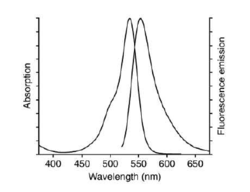Protocols for cell culture
Introduction
We have now observed CytoD-induced rheological changes of 3T3 fibroblasts. This experiment seeks to better understand the effect of CytoD on cells. Since there are significant rheological changes of 3T3 fibrob- last with CytoD, it is reasonable to assume that this chemical may modify the fibroblast cytoskeleton. The most important component of the mammalian cell cytoskeleton is actin, so we will image actin structures in these cells with and without CytoD treatment.
The actin cytoskeleton is visualized using phalloidin labeled with Alexa Fluor 532. The excitation maximum is at about 535nm and emission maximum is at about 575nm. Phalloidin is a fungal toxin (small organic molecule) that binds only to polymerized filamentous actin (F-actin), but not to actin monomers, G-actin. (It is a toxin because it hinders actin disassembly).
Cell Fixation and Labeling Protocol
Prepare a dish of fixed fibroblast cells (NIH 3T3) with actin labeled with phalloidin-Alexa Fluor 532. The labeling protocol is as follows: The starting point is as before - cells cultured in dishes containing DMEM++, at approximately 60% confluency. This is about the optimum percentage of cell population. If cells are too crowded, they will not stretch properly and show their beautiful actin filaments. Note also that these cells remain alive until the addition of formaldehyde, therefore requiring that any buffer/media added to be pre-warmed.
- Pre-warm the 3.7% formaldehyde solution in a hot water bath on the hotplate.
- Wash the cells twice with pre-warmed phosphate buffered saline (PBS) at pH 7.4. Remove the medium with a pipette and wash each dish twice with 2 mL of PBS.
- Fix the samples with 2 mL of 3.7% formaldehyde solution in PBS for 10 minutes at room temperature. - "Fixing" means cross-linking the intracellular proteins and freezing the cell structure. This kills the cells.
- Wash the cells three times with 2 mL PBS.
- Extract each dish with 2 mL 0.1% Triton X-100 (a type of soap solution in PBS) for 3-5 minutes. -"Extraction" refers to partially dissolving the plasma membrane of the cell.
- Wash the cells 2-3 times with PBS.
- Incubate the fixed cells with 2 mL 1% BSA (bovine serum albumin) in PBS for 20-30 minutes. -BSA blocks the nonspecific binding sites.
- Wash cells twice with PBS.
- To each cell dish, add 200 μL of fluorescent phalloidin solution (specific binding to F-actin) pre-mixed in methanolic (diluted methanol). Carefully pipet this just onto the central circular glass region of the dish, just enough to cover the cells, and incubate for 60 min. at room temperature.
- Wash three times with PBS.
- You can now store the sample at +4°C (normal refrigerator) in PBS for a few days, or in mounting medium for long-term storage (approx. up to 1 year).
By a very similar procedure, you should also prepare cells treated with CytoD. Between steps 2 and 3 of staining procedure, add 1 mL of the pre-warmed 10 μM CytoD solution for 20 min. Afterwards, wash with DMEM++ twice.
Actin Imaging
Since actin filaments and stress fibers are nm-scale objects, they are much dimmer than fluorescent beads or the dye solution - care must be taken to get good images of the cytoskeleton. You may need to cover the scope to reduce room light contamination.
Adjust the gain and the brightness of the camera to get the best picture. Be sure to keep the same exposure conditions, however, for both untreated and treated cells.
Using the 40x objective, take five images each of treated and untreated cells. You may have to average multiple captured image frames to obtain acceptable signal to noise levels.
References

